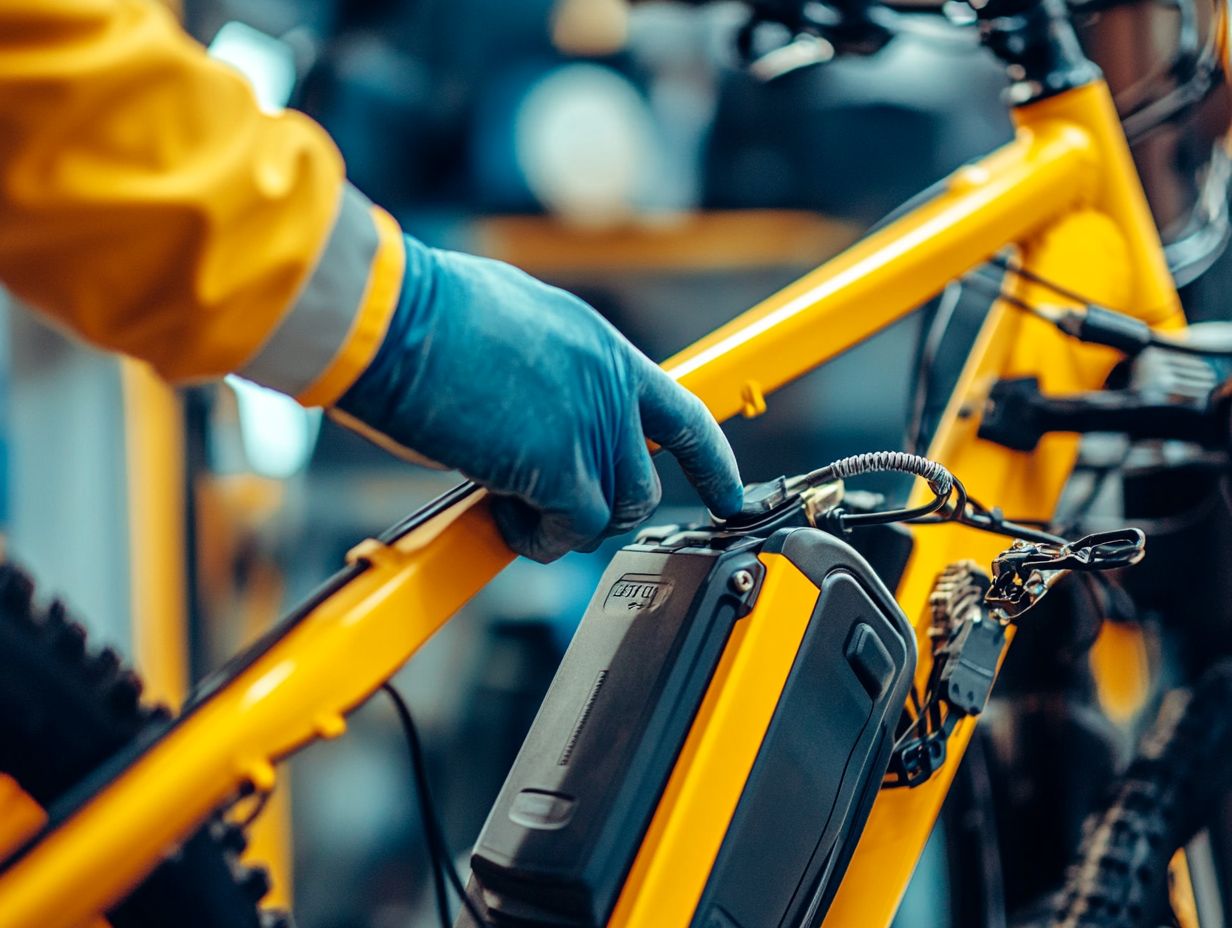How Do I Care for My E-Bike Battery?
E-bikes have revolutionized how you commute and explore. At the heart of this innovation is the battery.
Understanding the different types of e-bike batteries, what affects their lifespan, and the best maintenance practices is essential for enhancing your riding experience.
This article covers key charging techniques, regular maintenance tips, common troubleshooting methods, and signs that indicate when it s time to replace your battery.
Immerse yourself in this knowledge to ensure your e-bike operates smoothly and efficiently!
Contents
- Key Takeaways:
- Understanding E-Bike Batteries
- Caring for Your E-Bike Battery
- Troubleshooting Common Battery Issues
- Extending the Lifespan of Your E-Bike Battery
- Replacing Your E-Bike Battery
- Frequently Asked Questions
- What is the best way to care for my e-bike battery, considering the advancements in consumer electronics?
- How often should I charge my e-bike battery to maximize its lifespan?
- Can I leave my e-bike battery charging overnight safely?
- How can I extend the lifespan of my e-bike battery, similar to how GM and Ford manage their electric vehicles?
- What should I do if my e-bike battery is not holding a charge, considering the innovations in the e-bike industry?
- Can I use any charger to charge my e-bike battery, similar to those used for electric cars?
Key Takeaways:
- Understand the different types of e-bike batteries and the factors that affect their lifespan. This knowledge will help you make informed decisions on maintenance and replacement.
- Proper charging and storage, along with regular maintenance, greatly extend the lifespan of your e-bike battery.
- Troubleshoot common battery issues to identify and resolve problems before they become major concerns. Learn tips for prolonging the lifespan of your e-bike battery!
Understanding E-Bike Batteries
Knowing the intricacies of e-bike batteries is crucial for anyone interested in the dynamic e-bike landscape, where electric vehicles and sustainable transportation are becoming increasingly popular. These batteries, especially lithium-ion batteries, are designed to store a significant amount of energy and last a long time, making them ideal for e-bikes that promise efficient and eco-friendly travel options.
As you learn about the various types of e-bike batteries, consider their technological advancements and design features. This knowledge will enrich your understanding and enhance your overall experience.
Types of E-Bike Batteries
E-bike batteries come in various types, but you ll find that lithium-ion batteries are the most popular choice. They offer impressive energy storage and reliable performance, making them favorites among brands like Bosch PowerPack, Panasonic, and Samsung.
This technology is lightweight, allowing you to travel further without the burden of heavier battery types, such as lead-acid or nickel-metal hydride. While lead-acid batteries can be budget-friendly, their lower energy storage leads to shorter lifespans and decreased efficiency, making them less suitable for modern e-bikes.
In contrast, lithium-ion batteries provide longer charge cycles and recharge quickly, so you can get back on the road sooner.
Brands like Shimano and Brose have adopted lithium-ion solutions in their systems, showcasing its versatility and appeal among manufacturers. With advancements in battery management systems, you can expect enhanced safety and efficient power usage, solidifying lithium-ion as the leading technology in the industry.
Factors Affecting Battery Life
Several important factors can significantly impact the lifespan of your e-bike battery, including temperature effects, charge state, and best practices for charging and battery care.
When considering battery longevity, keep in mind the environmental conditions that could accelerate wear and tear. For instance, extreme temperatures either excessive heat or severe cold can negatively affect the chemical reactions within the battery, leading to reduced performance.
Your charging habits are also crucial; avoid complete discharges and don t frequently top off the charge. Embrace best charging practices by using the right chargers and charging at recommended times to maximize efficiency.
Routine maintenance extends battery life and enhances your overall e-bike experience.
Caring for Your E-Bike Battery
Taking care of your e-bike battery is essential for ensuring optimal performance and longevity. This involves key practices such as proper charging techniques, regular maintenance, and understanding safety around charging.
Prioritizing these aspects will enhance your riding experience and extend the life of your battery. Don’t wait until it s too late to learn about battery care!
Proper Charging and Storage

Properly charging and storing your e-bike battery is essential for maintaining its health. You need to follow specific practices to ensure optimal performance and longevity.
This means charging your battery at the recommended voltage levels, ideally between 20% and 80% capacity, to enhance its lifespan. It’s critical to steer clear of complete discharges and overcharging, as both can significantly reduce battery efficiency.
Charge your battery in cooler environments away from direct sunlight to prevent overheating. Regularly monitoring the battery’s condition and storing it in a dry, temperature-stable place will further enhance its vitality.
By adhering to these best practices, you not only elevate performance but also save yourself from costly replacements in the future.
Regular Maintenance
Regular maintenance of your e-bike battery is vital for extending its lifespan and ensuring consistent performance. It’s important to keep a close eye on its battery level and overall care.
To achieve optimal battery health, make it a habit to conduct routine checks on connections and terminals, ensuring they remain free from corrosion and dirt. A simple cleaning of the battery casing not only elevates its aesthetic appeal but also prevents grime buildup that could impact its functionality.
Monitoring the battery level is key. Steer clear of deep discharges and prioritize timely recharges to maintain a balanced energy cycle.
By embracing these proactive care measures, you can significantly enhance the longevity and performance of your e-bike battery. For instance, learning how to store your electric bicycle properly can lead to more enjoyable and worry-free rides.
Troubleshooting Common Battery Issues
Troubleshooting common battery issues is essential for every e-bike rider who wants to keep their rides smooth and enjoyable! By understanding how to charge the battery efficiently and recognizing signs of performance drops, you can significantly enhance your e-bike’s reliability.
This knowledge gives you the power to make informed decisions that keep your rides smooth and enjoyable.
Identifying and Resolving Problems
Identifying and resolving battery issues in your e-bike requires a keen eye for monitoring the battery level and recognizing signs of declining energy capacity that may indicate underlying problems.
If you notice a reduced range, like a significant drop in how far you can travel on a single charge, it often indicates battery degradation. Irregular charging patterns can add another layer of complexity; if your battery takes longer to charge or fails to charge fully, it s a clear red flag.
These issues not only diminish your riding experience but can also lead to more serious damage if not addressed swiftly. Taking action promptly through basic maintenance such as checking connections and ensuring proper storage conditions is crucial.
This proactive approach helps prolong the lifespan of your battery while ensuring it performs at its best.
Extending the Lifespan of Your E-Bike Battery
You can significantly extend the lifespan of your e-bike battery by embracing best practices in battery care. It’s essential to understand how temperature affects your battery’s performance, as well as the importance of regular e-bike maintenance.
By prioritizing these factors, you re setting the stage for optimal battery health and longevity.
Tips for Prolonging Battery Life

Implementing specific strategies to prolong your e-bike battery life can enhance its performance and longevity. Focus on best practices like monitoring the battery’s current power level.
Caring for your battery not only ensures longer journeys without the anxiety of running out of power but also minimizes the frequency of costly replacements. Regularly check your battery s charge level to avoid surprises on your ride!
Storing the battery in a cool, dry place is essential to prevent overheating, which can dramatically shorten its lifespan.
Cleaning the battery contacts regularly and avoiding complete discharges will also help maintain its health, allowing you to enjoy many miles ahead while maximizing your investment.
Replacing Your E-Bike Battery
Replacing your e-bike battery may become essential when you notice a decline in performance or battery lifespan. It s crucial to choose a new battery that adheres to high-quality battery standards to ensure optimal functionality.
This thoughtful selection will enhance your riding experience and keep your e-bike performing at its best.
When to Replace and How to Choose a New Battery
Understanding when to replace your e-bike battery and how to choose the right one is crucial for maintaining your ride’s efficiency. Key factors like energy density and proper battery care will significantly influence your decision.
Be on the lookout for several telltale signs that indicate it’s time for a battery replacement. If you notice reduced range, longer charging times, or any visible wear, take note. Regularly monitoring these indicators can help you avoid unexpected interruptions during your rides on your e-bike. For more detailed information on upkeep, check out this guide on how to maintain your electric bicycle for longevity.
Regarding selecting a new battery, compatibility with your e-bike model is paramount. If you are considering a Bosch PowerPack, for instance, also take note of the watt-hour capacity and discharge rates that align with your performance needs. Additionally, you may want to explore some tips for maintaining your electric bicycle battery to ensure longevity and efficiency.
Taking proper care of your new battery, such as managing its temperature and adhering to regular charging cycles, can extend its lifespan. This is especially true if you want to enjoy your ride e-bike without interruptions from reduced power.
Frequently Asked Questions
What is the best way to care for my e-bike battery, considering the advancements in consumer electronics?
The best way to care for your e-bike battery is to make sure it is charged properly, stored in a cool, dry place, and not overused. Additionally, understanding how to charge a battery correctly can further enhance its durability.
How often should I charge my e-bike battery to maximize its lifespan?

It is recommended to charge your e-bike battery after every use, especially if you are using high-performance models like Tesla Model S or Nissan Leaf, to maintain its health and performance.
Can I leave my e-bike battery charging overnight safely?
No, it is not recommended to leave your e-bike battery on the charger overnight, just as you wouldn t with consumer electronics. It is best to unplug it once it is fully charged to avoid overcharging and damaging the battery.
How can I extend the lifespan of my e-bike battery, similar to how GM and Ford manage their electric vehicles?
To extend the lifespan of your e-bike battery, it is important to regularly charge it, avoid overcharging, and keep it away from extreme temperatures, much like the guidelines followed by companies such as Yamaha and Panasonic.
What should I do if my e-bike battery is not holding a charge, considering the innovations in the e-bike industry?
If your e-bike battery is not holding a charge, try cleaning the charging port and contacts, and make sure it is fully plugged in. If the issue persists, it may be time to replace the battery with a model from a reputable manufacturer like Aventon.
Taking care of your e-bike battery will ensure you enjoy countless journeys ahead!
Can I use any charger to charge my e-bike battery, similar to those used for electric cars?
No, you must use the charger designed for your e-bike battery. This is important to avoid damaging the battery.
Using a different charger can cancel your warranty. Always choose the right charger for the best performance!






